Nike's Phil Knight
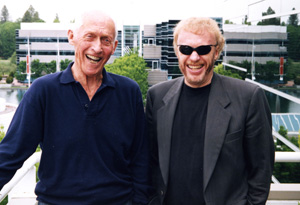
Coach Bill Bowerman and Phil Knight
Nike co-founder and chairman Phil Knight has been called the most powerful man in sports, changing the way the world works out and making athletes of all ages feel like they can be a champion. But long before "Just Do It" became a household phrase and before the iconic swoosh was instantly recognizable, Phil was just a boy from Portland, Oregon, who dreamed of playing in the majors.
"Up until the time I was 14 years old, I was sure that I was going to be a big-league baseball player. But that dream came to a rude awakening when I got cut from my high school baseball team," he says. So instead of the baseball diamond, Phil took to the track. In 1955, he enrolled in the University of Oregon, where he ran track for renowned coach Bill Bowerman.
Phil calls Bill "the greatest track coach that ever lived," but aside from their love of running, they also shared the belief that the existing track shoes were slowing runners down. So Phil began importing better-quality running shoes from Japan, and in 1964, with a handshake and $500 apiece, Phil and Bill launched Blue Ribbon Sports.
"Up until the time I was 14 years old, I was sure that I was going to be a big-league baseball player. But that dream came to a rude awakening when I got cut from my high school baseball team," he says. So instead of the baseball diamond, Phil took to the track. In 1955, he enrolled in the University of Oregon, where he ran track for renowned coach Bill Bowerman.
Phil calls Bill "the greatest track coach that ever lived," but aside from their love of running, they also shared the belief that the existing track shoes were slowing runners down. So Phil began importing better-quality running shoes from Japan, and in 1964, with a handshake and $500 apiece, Phil and Bill launched Blue Ribbon Sports.
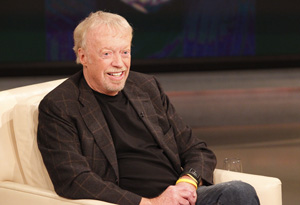
Photo: George Burns/Harpo Studios
In the early years of the company, Phil sold shoes out of his car at track meets. Then, in 1972, Phil and Bill began manufacturing their own shoes. Bill used his wife's waffle iron to create a shoe with greater traction than those currently on the market. "The idea was that we can make shoes that runners want," Phil says.
The new design revolutionized running and inspired Phil and Bill to rename their company. Phil says one of his 45 employees suggested the name Nike, which was the name of the Greek goddess of victory. "There was also a missile, which we thought denoted speed, and then the marketing textbooks say to have a hard sound in your trademark," Phil says. Though he wasn't a huge fan of the name at first, Phil says it has grown on him. "I quite like it now."
Watch as Phil explains the Nike name and logo
The Nike swoosh came about in a similar fashion. "Now that we had a name, we had to have a trademark for the side of the shoe. It was 1971, and Ford had spent $2 million getting a trademark. We didn't have $2 million, so I went by the graphic arts department at Portland State, and there was a woman there saying, 'I don't know how I'm going to get enough money for the dress for this prom,'" Phil says. "And I said, 'I have a job for you.' I paid her $2 an hour, and she spent 17 and a half hours. So $35 and she came up with what is now the swoosh."
When Nike went public in 1980, Phil says he gave the creator of the swoosh a few hundred shares of stock, which she has held onto. These shares are now worth quite a bit of money. "She's doing okay," he says.
The new design revolutionized running and inspired Phil and Bill to rename their company. Phil says one of his 45 employees suggested the name Nike, which was the name of the Greek goddess of victory. "There was also a missile, which we thought denoted speed, and then the marketing textbooks say to have a hard sound in your trademark," Phil says. Though he wasn't a huge fan of the name at first, Phil says it has grown on him. "I quite like it now."
Watch as Phil explains the Nike name and logo
The Nike swoosh came about in a similar fashion. "Now that we had a name, we had to have a trademark for the side of the shoe. It was 1971, and Ford had spent $2 million getting a trademark. We didn't have $2 million, so I went by the graphic arts department at Portland State, and there was a woman there saying, 'I don't know how I'm going to get enough money for the dress for this prom,'" Phil says. "And I said, 'I have a job for you.' I paid her $2 an hour, and she spent 17 and a half hours. So $35 and she came up with what is now the swoosh."
When Nike went public in 1980, Phil says he gave the creator of the swoosh a few hundred shares of stock, which she has held onto. These shares are now worth quite a bit of money. "She's doing okay," he says.
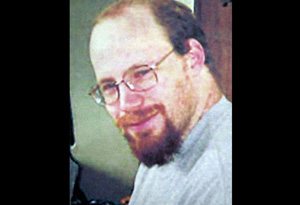
Matthew Knight
Bill passed away in 1999, but Phil says this legendary coach's influence on him is everlasting. "He was a great leader and great man, and being able to be associated with him is a big part of the dream," Phil says. "He was about teaching you how to respond competitively to different challenges. Obviously, they were on the track, and they were about getting prepared to compete and competing well and competing better than you thought you could do, and accepting victory and defeat."
Phil suffered another great loss in 2004 when his son Matthew died in a scuba diving accident. This kind of tragedy is something no parent should ever have to face, Phil says. "It aged me much faster than anything you can imagine," he says. "Matt had two sons, and they are now 7 and 10. The 10-year-old's the absolute spitting image of him. They're absolutely great kids and are a huge help."
In January 2011, Phil helped dedicate the new Matthew Knight Arena at the University of Oregon in memory of his son.
Phil suffered another great loss in 2004 when his son Matthew died in a scuba diving accident. This kind of tragedy is something no parent should ever have to face, Phil says. "It aged me much faster than anything you can imagine," he says. "Matt had two sons, and they are now 7 and 10. The 10-year-old's the absolute spitting image of him. They're absolutely great kids and are a huge help."
In January 2011, Phil helped dedicate the new Matthew Knight Arena at the University of Oregon in memory of his son.
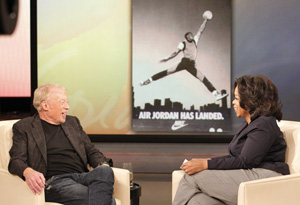
Photo: George Burns/Harpo Studios
Today, Nike works with many world-class athletes like Serena Williams, Mia Hamm, Roger Federer and Tiger Woods. At the headquarters in Beaverton, Oregon, the Nike Sports Research Lab often hosts elite athletes to test new products. "They're very demanding. They want lighter, better, faster shoes and lighter, better, faster clothes ," Phil says. "Meeting sports athletes that are the best in the world is a thrill to this day. That never changes. I was that way when I was 12, and I'm that way now."
Take a tour of Nike's world headquarters
Phil says there are definitely days when he marvels at what Nike has become over the years. "We knew the industry would get bigger. We had no idea ... we would compete as successfully as we have. It was all a labor of love in the early days and really to this day," he says. "It's a fabulous industry, and the people who work out there, they love being in it. I mean, it's sports, it's fitness, it's international."
One of Nike's most famous partnerships is with global inspiration and sports icon Michael Jordan. The company signed the basketball player in 1984, before he had even stepped on the court for the Chicago Bulls. "He was a great player, he was handsome, he was articulate, he was educated and he was perfect," Phil says."He was sent from central casting, and we jumped on it right away."
Through the years, Michael Jordan has become a brand within the brand. Nike sells about double the Jordan product today compared to what they did when he was playing at the peak of his career, Phil says. "It's become more than just the man," he says. "It stands for something by itself."
Take a tour of Nike's world headquarters
Phil says there are definitely days when he marvels at what Nike has become over the years. "We knew the industry would get bigger. We had no idea ... we would compete as successfully as we have. It was all a labor of love in the early days and really to this day," he says. "It's a fabulous industry, and the people who work out there, they love being in it. I mean, it's sports, it's fitness, it's international."
One of Nike's most famous partnerships is with global inspiration and sports icon Michael Jordan. The company signed the basketball player in 1984, before he had even stepped on the court for the Chicago Bulls. "He was a great player, he was handsome, he was articulate, he was educated and he was perfect," Phil says."He was sent from central casting, and we jumped on it right away."
Through the years, Michael Jordan has become a brand within the brand. Nike sells about double the Jordan product today compared to what they did when he was playing at the peak of his career, Phil says. "It's become more than just the man," he says. "It stands for something by itself."
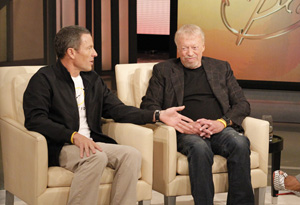
Photo: George Burns/Harpo Studios
Another elite Nike athlete is golf superstar Tiger Woods. Many companies dropped Tiger when his infidelity scandal became tabloid fodder and national news, but Nike made a point of saying that they were sticking by him. "We think that athletes are human beings and have foibles just like human beings do," Phil says. "We've known [Tiger] for 18 years and worked with him for 15, and he had a three-year span in there where he kind of went off the reservation a little bit in some of the things he was doing, which he apologized to the company and everybody involved. We think the essence of Tiger Woods is basically very, very good, and over the long run, people will see that."
Seven-time Tour de France winner Lance Armstrong says Phil and Nike have stood beside him through career highs and lows—like doping allegations—as well. "[After] winning the tour, a lot of people ask questions, a lot of people say, 'How?' A lot of people have serious questions, and these guys never flinched," Lance says. "I'm so very appreciate of that, and it's been a great partnership."
Watch Lance Armstrong surprise Phil Knight
Lance's partnership with Nike is also the force behind the Livestrong yellow wristband. Proceeds from bracelet sales benefit the Lance Armstrong Foundation, which provides support for people affected by cancer. To date, there have been about 80 million yellow wristbands sold. "Through this partnership, Phil and Nike have helped Livestrong raise $93 million to help fight cancer," Lance says. "That's nearly a quarter of what we've raised in our entire life span."
More from the show
See how the Nike shoe has changed over the years
Tour the Nike campus
Who designed the Nike swoosh? Find out!
Seven-time Tour de France winner Lance Armstrong says Phil and Nike have stood beside him through career highs and lows—like doping allegations—as well. "[After] winning the tour, a lot of people ask questions, a lot of people say, 'How?' A lot of people have serious questions, and these guys never flinched," Lance says. "I'm so very appreciate of that, and it's been a great partnership."
Watch Lance Armstrong surprise Phil Knight
Lance's partnership with Nike is also the force behind the Livestrong yellow wristband. Proceeds from bracelet sales benefit the Lance Armstrong Foundation, which provides support for people affected by cancer. To date, there have been about 80 million yellow wristbands sold. "Through this partnership, Phil and Nike have helped Livestrong raise $93 million to help fight cancer," Lance says. "That's nearly a quarter of what we've raised in our entire life span."
More from the show
See how the Nike shoe has changed over the years
Tour the Nike campus
Who designed the Nike swoosh? Find out!



